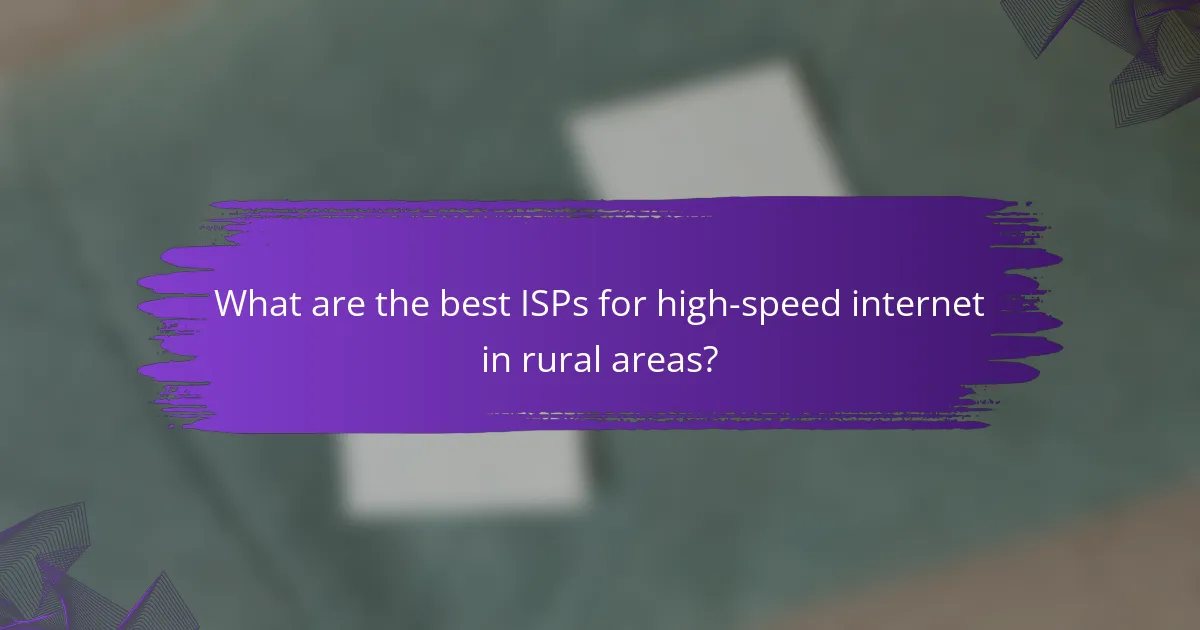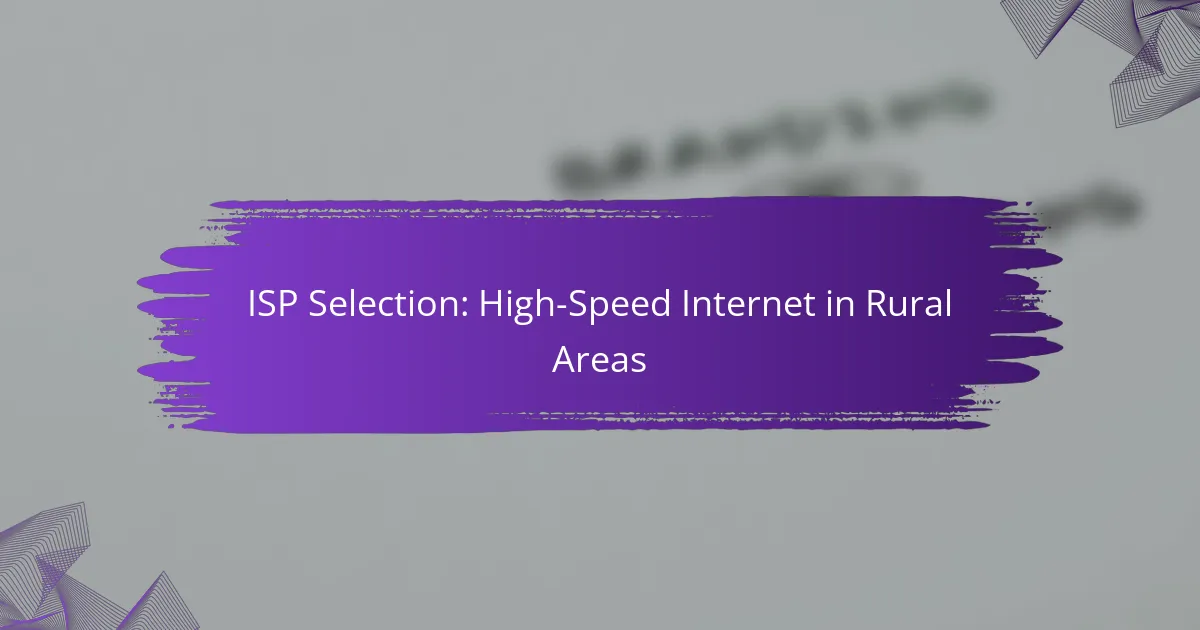Selecting the right ISP for high-speed internet in rural areas is crucial for ensuring reliable connectivity. Key considerations include coverage, pricing plans, and customer service, which can significantly impact your internet experience. With various providers like BT Broadband, Sky Internet, and Virgin Media available, understanding the unique challenges of rural internet access can help you make an informed choice.

What are the best ISPs for high-speed internet in rural areas?
The best ISPs for high-speed internet in rural areas typically include BT Broadband, Sky Internet, Virgin Media, TalkTalk, and Hyperoptic. These providers offer various plans and technologies that cater to the unique needs of rural customers, often focusing on reliability and speed.
BT Broadband
BT Broadband is a leading choice for rural high-speed internet, offering a range of packages that include fiber and standard broadband options. Their fiber plans can deliver speeds up to 900 Mbps, making them suitable for households with multiple users and devices.
When considering BT, check for availability in your area, as coverage can vary significantly. They often provide incentives like cashback or free installation, which can enhance the overall value of their service.
Sky Internet
Sky Internet is known for its competitive pricing and flexible packages, including options for both standard and fiber broadband. Their fiber service can reach speeds of up to 500 Mbps, which is ideal for streaming and gaming in rural settings.
Sky also offers a unique feature called Sky Q, which allows for seamless streaming across multiple devices. Be sure to review their customer service ratings, as user experiences can vary widely.
Virgin Media
Virgin Media provides some of the fastest broadband options available, with speeds that can exceed 1 Gbps in select areas. This makes them an excellent choice for tech-savvy users in rural locations who require high-speed connectivity.
However, Virgin Media’s coverage is more limited in rural areas compared to urban centers, so it’s crucial to verify service availability. They often bundle broadband with TV and phone services, which can lead to cost savings.
TalkTalk
TalkTalk is recognized for its budget-friendly broadband plans, making it an attractive option for rural customers looking to save on internet costs. Their fiber packages offer speeds up to 67 Mbps, which is sufficient for everyday browsing and streaming.
Consider their no-contract options if you prefer flexibility. TalkTalk also provides a price promise, ensuring that your monthly rate won’t increase unexpectedly, which is a significant advantage for budgeting.
Hyperoptic
Hyperoptic specializes in delivering ultra-fast fiber broadband, with speeds reaching up to 1 Gbps. Although their service is primarily available in urban areas, they are expanding into select rural communities, offering a high-performance alternative.
When evaluating Hyperoptic, check their installation process, as it may require additional setup compared to traditional ISPs. Their customer service is often rated highly, which can enhance your overall experience.

How to choose an ISP for rural high-speed internet?
Choosing an ISP for rural high-speed internet involves assessing coverage, comparing pricing plans, and evaluating customer service. These factors ensure you select a provider that meets your connectivity needs while offering reliable support.
Assess coverage availability
Coverage availability is crucial when selecting an ISP in rural areas, as not all providers reach every location. Start by checking the ISP’s website for coverage maps or use online tools to verify service in your specific area.
Consider local feedback and community forums to learn about real-world experiences with different ISPs. This can help you identify which providers reliably deliver high-speed internet in your region.
Compare pricing plans
Pricing plans can vary significantly among ISPs, so it’s essential to compare them carefully. Look for plans that offer competitive rates while meeting your speed requirements, typically ranging from 25 Mbps to over 100 Mbps for high-speed internet.
Be aware of additional costs such as installation fees, equipment rentals, and data caps. Some ISPs may offer promotional rates that increase after a set period, so read the fine print before committing.
Evaluate customer service ratings
Customer service ratings are an important aspect of choosing an ISP, especially in rural areas where technical support may be needed more frequently. Research customer reviews on platforms like Trustpilot or local forums to gauge satisfaction levels.
Look for ISPs that provide multiple support channels, such as phone, chat, and email. A provider with a strong reputation for responsive and helpful customer service can make a significant difference in your overall experience.

What factors affect high-speed internet availability in rural areas?
High-speed internet availability in rural areas is influenced by several key factors, including geographical obstacles, infrastructure investment, and population density. Understanding these elements can help residents make informed decisions about their internet service providers (ISPs) and available options.
Geographical obstacles
Geographical obstacles such as mountains, forests, and rivers can significantly hinder the deployment of high-speed internet infrastructure. These natural barriers may limit the reach of cable and fiber-optic networks, making it challenging for ISPs to provide service to remote locations.
In some cases, satellite internet may be a viable alternative, but it often comes with higher latency and variable speeds. Residents should assess their local geography when considering internet options and consult with ISPs about the best solutions for their specific area.
Infrastructure investment
The level of infrastructure investment in a region directly impacts the availability of high-speed internet. Rural areas often receive less investment compared to urban centers, leading to fewer options for residents. Government programs and incentives can sometimes help bridge this gap by encouraging ISPs to expand their networks.
When evaluating ISPs, look for those that have a commitment to investing in rural infrastructure. This may include partnerships with local governments or participation in federal funding initiatives aimed at improving internet access.
Population density
Population density plays a crucial role in determining high-speed internet availability. Areas with lower population density may not generate enough demand to justify the cost of deploying advanced internet technologies. As a result, ISPs may prioritize urban or suburban markets where they can achieve higher returns on investment.
Residents in sparsely populated areas should explore community initiatives or cooperatives that aim to enhance internet access. These efforts can sometimes lead to improved service options and better pricing through collective bargaining with ISPs.

What technologies provide high-speed internet in rural areas?
High-speed internet in rural areas can be delivered through various technologies, each with its own advantages and limitations. The most common options include fibre-optic connections, fixed wireless technology, and satellite internet services.
Fibre-optic connections
Fibre-optic connections use thin strands of glass or plastic to transmit data as light signals, offering some of the fastest internet speeds available. This technology is ideal for rural areas where infrastructure is developed, providing speeds that can exceed 1 Gbps.
However, the main consideration is the availability of fibre networks, as installation can be costly and time-consuming. If you live in a remote area, check with local providers to see if fibre is an option and inquire about any installation fees that may apply.
Fixed wireless technology
Fixed wireless technology delivers internet access through radio signals from a local tower to a receiver at your home. This option is often more affordable and quicker to deploy than fibre, making it suitable for many rural communities.
Speeds typically range from 5 to 50 Mbps, depending on the provider and distance from the tower. When considering fixed wireless, ensure that there is a clear line of sight to the tower, as obstructions can significantly impact performance.
Satellite internet services
Satellite internet services provide coverage almost anywhere, making them a popular choice for very remote areas. Data is transmitted to and from satellites orbiting the Earth, allowing users to access the internet without the need for extensive infrastructure.
While satellite internet can offer speeds between 12 and 100 Mbps, latency can be an issue, often exceeding 600 ms. This can affect activities like gaming or video conferencing. When choosing satellite services, consider the data caps and pricing plans, as they can vary widely among providers.

What are the common challenges of high-speed internet in rural areas?
High-speed internet in rural areas often faces several challenges, including limited infrastructure, fewer service providers, and potential higher costs. These issues can significantly affect availability, speed, and reliability for residents and businesses alike.
Limited ISP options
Rural areas typically have fewer Internet Service Providers (ISPs) compared to urban regions, which limits consumer choice. Many rural communities may only have access to one or two providers, often leading to higher prices and less competitive service offerings.
When selecting an ISP in a rural area, it’s essential to research available options thoroughly. Check for local providers, as well as larger companies that may offer service in your region. Consider factors such as customer reviews, service reliability, and pricing plans.
Some rural areas may benefit from community broadband initiatives or co-ops that aim to improve internet access. Engaging with local government or community organizations can provide insights into these options and help advocate for better services.
